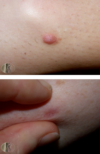Benign Skin Neoplasms Flashcards
seborrheic keratosis
benign superficial raised (epidermal) growth
always have a stuck-on quality, like a glob of wax smushed onto the skin
common after age 30
can arise on all body surfaces except palms and soles, tan or brown or sometimes black
sometimes have “fissures” or “cracks” on the surface

How can you tell if a lesions is a seborrheic keratosis?
try gently picking at or scratching the lesion
may crumble, flake, or life off, revealing the superfiicial waxy character
What is the treatment for seborrheic keratoses?
often multiple and can be extensive
individual lesions do not go away, but treatment is not necessary
What is solar lentigo (lentigines)?
aka “sun spot”, “age spot”, or “liver spot”
see flat brown macules (lighter brown than typical nevi)
located on upper back, shoulders, chest, dorsal hands, arms
due to sun damage, but NOT cancerous or precancerous
not treatment is required

What is the histological features of lentigos?
increased melanin, NO increase in the number of melanocyte cells
pigmented rete ridges
solar elastosis

What is the treatment and prevention of solar lentigo?
no treatment required
prevention = sun protection
How do you distinguish between solar lentigo and melanoma?
lentigos will not turn into melanomas, but one with a lot of these is a marker of increased melanoma risk
look for the ugly duckling:
- color (darker, multiple, variegated)
- diamter (>6 mm)
evolving
consider biopsy or referral to a dermatologist for any lesion that stands out as different
What are acrochordons?
skin tags - soft fleshy papules in axilae, neck, groin, and eyelids
skin colored to brown
often pedunculated (connected to skin wil small stalk)
no need to treat unless inflamed - can be frozen off

What is dermatofibroma?
single small round firm papule 0.5-1cm
pink, reddish brown, somtimes hyperpigmented
“Dimple sign” - raises up on the side and dimples down in the center when squeezed
most common on lower extremities
initiated by injuries to skin such as insect bites of inflamed hair follicles (scar)

What is keloid?
firm, hyperpigmented, pink or red papule or nodule
often shiny or smooth surface
usually at the site of previous known tissue trauma (cut, laceration, burn, sometimes acne, piercing)
excess scar tissue gone “out of control”
lesions can be tendor or itchy

What are cherry angiomas?
shiny bright red papules
located on trunk but can be anywhere (face, scalp)
likely genetic
common to have multiple spots
can increase in number during pregnancy

What are the histological features of cherry angiomas?
raised bump with dilated capillaries

What is pyogenic granuloma?
ERUPTIVE, small solitary, sessile or pedunculated vascular (RED), raised papule
bleeds easily with trauma
relative quick onset

What is epidermal inclusion cyst (EIC)?
mobile subcutaneous nodule, often with an overlying punctum
EICs arise from hair follicles
debris (dead skin cells, oil, etc.) collects within a sack
may discharge foul smelling cheesy white material
What are the histological findings of epidermal inclusion cysts?
sac underneath the skin

What is the treatment for EICs?
benign and require no treatment
however, when traumatized, EICs may rupture in the skin, creating an abscess which may require incision and drainage
unlike a bacterial abscess, ruptured EICs tend to be sterile and and do not require oral antibiotics
presence of a preceeding EIC differentiates from bacterial abscess, and both types require I and D
What is a lipoma?
soft, ill-defined, rubbery, painless subcutaneous nodule

What is the technique for estimating body surface area?
use the patient’s hand -> about 1% of body surface
one fingertip unit is enough medication to cover 2% body surface area
rule of 9s - arm about 9% of BSA, leg 18%, head 9%, front of trunk 18%, back of trunk 18%
methotrexate
folic acid analog
competitive antagonist of dihydrofolate reductase
blocks the synthesis of purine nucleotides required for DNA synthesis -> inhibition of cell division (S phase)
as a result, blocks proliferation and activity of lymphoid cells (T cells)
anti-inflammatory effects mediated by other pathways (adenosine)
indications - psoriasis

azathioprine
purine analog (structurally similar but different enough
when incorporated into nucleic acid leads to inhibition of DNA and RNA synthesis
inhibits cell division of lymphocytes, depresses T-cell mediated functions, depresses B cell antibody production
refractory eczema, Chron’s, post-organ transplant immunosuppression

5-fluorouracil (Efudex)
structural analog of uracil
when incorporated into RNA, disrupts RNA synthesis
incorporated preferentially into rapidly dividing cells
treatment of actinic keratosis - topical medication
cyclosporine
calcineurin inhibitor
prevents the expression of IL-2 and other genes needed for T-cell activation
used orally for psoriasis, immune suppression in post-organ transplant

tacrolimus
calcineurin inhibitor
prevents expression of IL-2 and other genes needed for T-cell activation
used topically for treatment of eczema as a steroid sparing agent

imiquomod
activator of toll-like receptor 7 on dendritic cells
induces pro-inflammatory state
induces TNF-alpha, IFN-gamma, IFN-alpha, activates T cells
antiviral and anti-tumor effect
treatment for genital warts and superficial basal cell carcinomas


